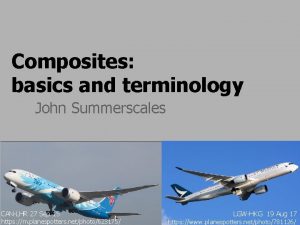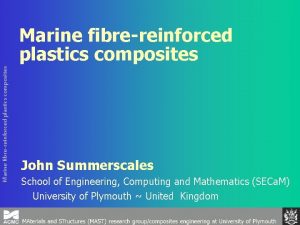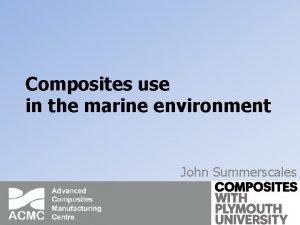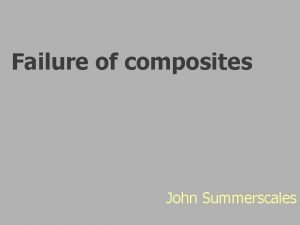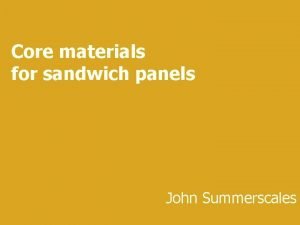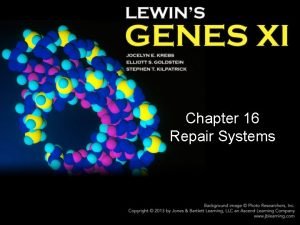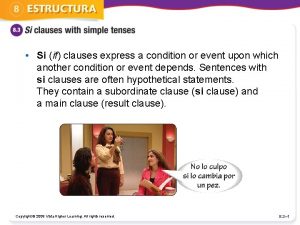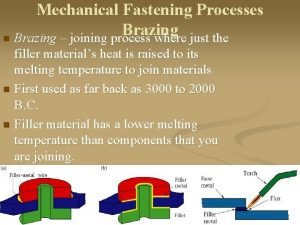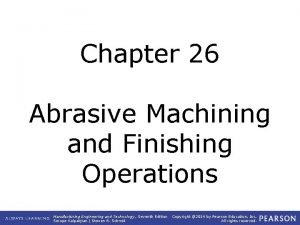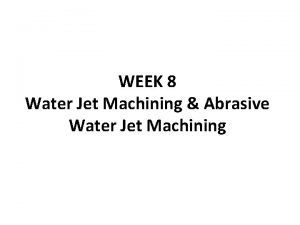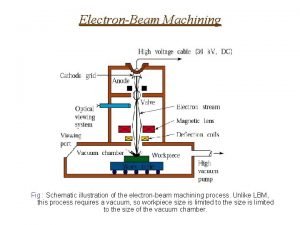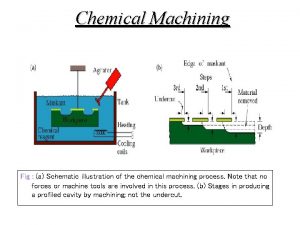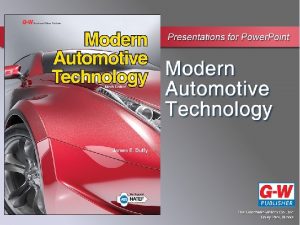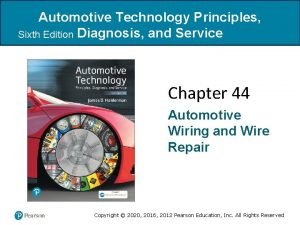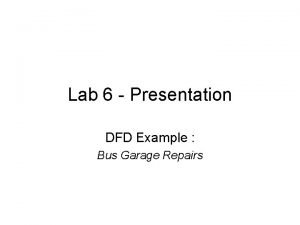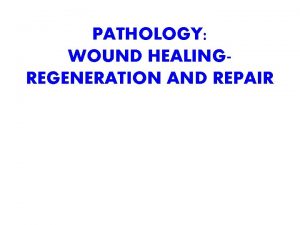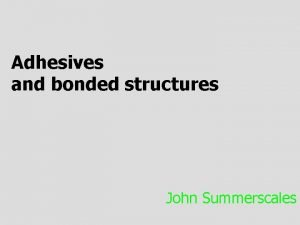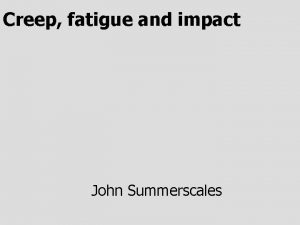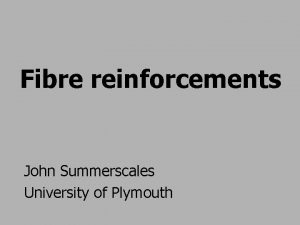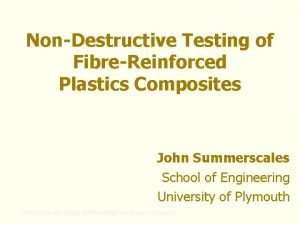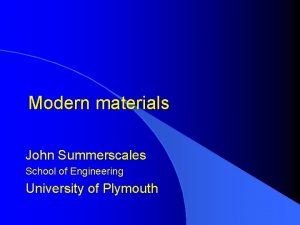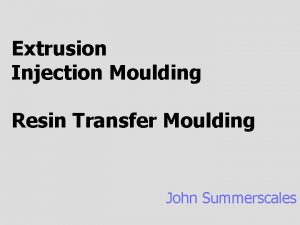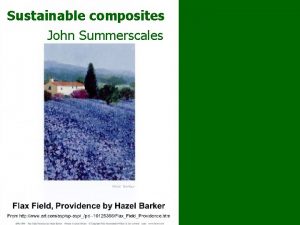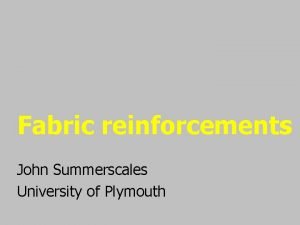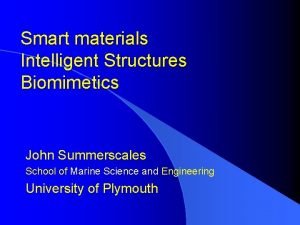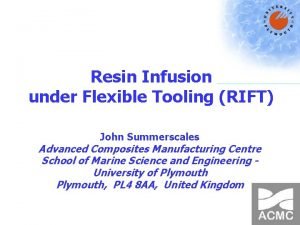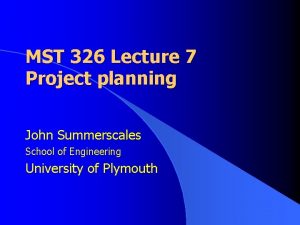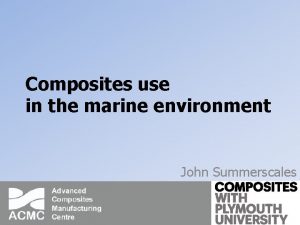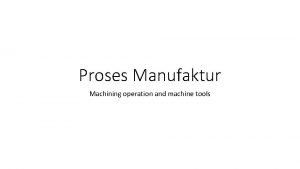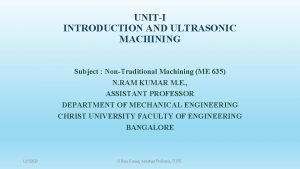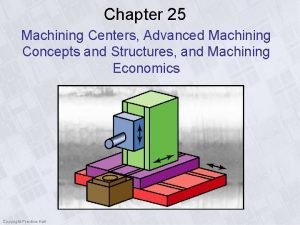Machining joining and repair John Summerscales Machining health












![Correct joint design. . . redrawn from diagrams in The [Permabond] Engineers Guide to Correct joint design. . . redrawn from diagrams in The [Permabond] Engineers Guide to](https://slidetodoc.com/presentation_image_h/ff36cddced14c0896670b648008fc8c1/image-13.jpg)
![Wrong joint design. . . redrawn from diagrams in The [Permabond] Engineers Guide to Wrong joint design. . . redrawn from diagrams in The [Permabond] Engineers Guide to](https://slidetodoc.com/presentation_image_h/ff36cddced14c0896670b648008fc8c1/image-14.jpg)











- Slides: 25

Machining, joining and repair John Summerscales

Machining: health and safety • machining of composites is probably of greater risk than the potentially toxic chemicals used in composites manufacture • if the latter are handled with due respect • dust and decomposition products arise • essential to minimise this risk by • • extraction at source, or entrapment in a stream of gas or water.

Machining of composites • heterogeneous, anisotropic structure • hence greater similarity to wood than to Fe/Al • low heat dissipation • low coefficient of thermal expansion hot tool expands more rapidly then work-piece. • coefficient of thermal expansion for a hole? •

Coefficient of thermal expansion for a hole • in an unconstrained plate of material, the material expands as normal • the air in the hole has ‘near zero’ mechanical properties • CTE of the hole is the same as for the material containing the hole.

Machining of composites • cutting composite materials/structures wears cutting tools more rapidly than cutting traditional engineering materials. • tool durability and initial cost: • high speed steel << carbide < boron nitride (BN) or polycrystalline diamond (PCD) • more expensive cutting tool is cost-efficient when costs calculated over tool-life • surface finish will be smoother •

Machining: water-jet • normally conducted with abrasive powder • e. g. garnet injected into the jet. • for abrasive water jet cutting (AWC), • flow speeds of 850 m/s • 4 -8 litres/min through a 0. 8 mm diameter hole cut is ~0. 5 -2. 5± 0. 4 mm wide and tapered • water absorption may be an issue, especially for • • • materials with weak fibre-matrix interfaces aramid composites

Machining: LASER • CO 2 LASER cutting beam of 0. 1 -1. 0 mm focussed diameter • co-axial inert gas • depth of focussed field is proportional to spot-size • tolerance is typically ± 0. 5 mm. • • Ease of cutting: aramids are easily machined with lasers • glass is intermediate, and • carbon is difficult because of its high thermal conductivity. •

Machining - aramids • special tools and techniques are appropriate • e. g. band saw: fine tooth blade (550 -866 teeth/m) • straight-set or raker-set teeth • operate at high speed to stretch and shear • to minimise the production of fuzz and keep the teeth from snagging fibres run the blade in reverse (teeth pointing upwards) • • H&S issues with sub-diameter particles • also relevant for natural fibre composites?

Joining: fasteners • in general, double lap joints preferable to single lap shear joints • fasteners should normally be: 2 - 4 diameters from edge, and • 3 - 4 diameters from adjacent fasteners • • Stress analysis dependent on: any pre-load • stacking sequence • free-edge effects, etc •

Joining: fasteners • typical failures include: bearing failure, • shear-out, • cleavage, and • direct failure of substrate or fastener material • • important considerations in joint design: matrix creep: torque applies compressive stress in the unreinforced direction of the laminate • galvanic corrosion: • • • C and Al at opposite ends of the electrochemical corrosion series thin fibreglass layer minimises such corrosion

Big. Head Bonding Fasteners images from: http: //www. bighead. co. uk/ • Extended heads to spread load:

Joining: adhesive bonding • adhesive joints spread load over more uniform area than fasteners o result in a lower stress concentration o • good joint design is essential for highly-stressed applications • joints: best loaded in compression o acceptable performance in shear o avoid tension, especially peel and cleavage o
![Correct joint design redrawn from diagrams in The Permabond Engineers Guide to Correct joint design. . . redrawn from diagrams in The [Permabond] Engineers Guide to](https://slidetodoc.com/presentation_image_h/ff36cddced14c0896670b648008fc8c1/image-13.jpg)
Correct joint design. . . redrawn from diagrams in The [Permabond] Engineers Guide to Adhesives • Compression good Shear OK KEY: adhesive substrate
![Wrong joint design redrawn from diagrams in The Permabond Engineers Guide to Wrong joint design. . . redrawn from diagrams in The [Permabond] Engineers Guide to](https://slidetodoc.com/presentation_image_h/ff36cddced14c0896670b648008fc8c1/image-14.jpg)
Wrong joint design. . . redrawn from diagrams in The [Permabond] Engineers Guide to Adhesives • Peel (one flexible) Cleavage (two rigid) x x

Bonding - surface preparation • Surface preparation is crucial to achievement of a good bond • for composites normally degrease-abrade-degrease-dry sequence shot-blasting the surface is inappropriate: it tends to remove too much substrate o plastic bead blasting (or similar blast media) permits greater control of material removal o aerospace industry avoids silicone release: o • material transfer to the part surface can cause significant weakening of the subsequent bond.

Joining: welding thermoplastics • joining of thermoplastic matrix composites: o heat - compress - intermolecular diffusion - cool • variety of techniques to heat the substrates: o o o hot-plate resistance heating/induction heating infrared/laser dielectric/microwave friction-inertia/vibration welding ultrasonic welding • solvent welding also possible o beware health and safety and solvent entrapment

Painting/surface coatings • painting of composite substrates o surface preparation as for adhesive bonding • current trend towards in in-mould coating eliminates solvents in the workplace o reduces labour required o more uniform coating thickness o • • but only on horizontal surfaces in compression moulding PU research funded by • DTI Technology Programme/Zero Emission Enterprises • EU REA grant FP 7 -SME-2011 -1 -286520.

Gel-coat application • By hand-painting or spray onto the open mould. o The process releases volatile organic compounds (VOC) into the workplace and the environment. • By mould-opening and flow into the space o o horizontal surfaces increase by the required distance vertical surfaces see no increase in space

New in-mould process • In. Ge. Ct IMGC (in-mould gel-coating) o applicable to RTM, RIFT and similar processes o mould cavity divided by a separator layer o separator has texture to v v provide stand-off from mould surface enhance physical bond to laminate and gel-coat o IPR protected by British Patent GB 2 432 336 A • In. Ge. Ct IMS (in-mould surfacing) o silicone shim defines space for gel coat o mould laminate – remove shim – inject gelcoat

IMGC concept • as for RTM, but with two injection ports: Separator layer Gel-coat injection Mould tool Gel-coat Laminate Mould tool Laminate injection

In. Ge. Ct double tetrahedron mould challenging geometry for test mould tool

Repair • before repair, non-destructive evaluation o to determine full extent of damage • design the repair o for a general repair • o the hole is normally tapered at ten times the depth for an aerospace repair • the hole is normally tapered at fifty-times the depth or at 12. 7 mm/ply (half-inch/ply) • appropriate machining techniques o to remove the failed material • rebuild the laminate

Repair - sandwich panels • it may be practical to: replace just one laminate skin, or o replace one skin and the core, leaving the second face intact. o • foaming adhesive used to bond-in replacement honeycomb.

Self-healing composites • proposed use of hollow glass fibres containing uncured resin: low viscosity resin systems generally do not achieve the highest mechanical properties o high viscosity resin systems would require some form of pressure to facilitate flow o how to mix and flow with no applied pressure ? o • University of Delaware Center for Composite Materials is developing biomineralisation as a route to the repair of the fibre network

Summary • Machining cutting o abrasive water jet o laser o • Joining fasteners o adhesive bonding o welding thermoplastic o painting/surface coating o • Repair
 John summerscales
John summerscales John summerscales
John summerscales John summerscales
John summerscales Micro milli nano
Micro milli nano John summerscales
John summerscales John summerscales
John summerscales Base excision repair
Base excision repair Mismatch repair
Mismatch repair Thank you for joining us church
Thank you for joining us church Reproductive system vocabulary
Reproductive system vocabulary What is a ctso and what are the benefits of joining
What is a ctso and what are the benefits of joining Video platform
Video platform Joining clauses with if and when
Joining clauses with if and when Mechanical fastening process
Mechanical fastening process Joining together group theory and group skills
Joining together group theory and group skills Abrasive manufacturing process
Abrasive manufacturing process Disadvantages of abrasive water jet machining
Disadvantages of abrasive water jet machining Electron beam machining diagram
Electron beam machining diagram Chemical machining applications
Chemical machining applications Health and social care component 3 health and wellbeing
Health and social care component 3 health and wellbeing Whats primase
Whats primase Chapter 81 brake system diagnosis service and repair
Chapter 81 brake system diagnosis service and repair Modified macpherson strut
Modified macpherson strut Peak and hold injector waveform
Peak and hold injector waveform Chapter 44 automotive wiring and wire repair
Chapter 44 automotive wiring and wire repair Data flow diagram for parking management system
Data flow diagram for parking management system
